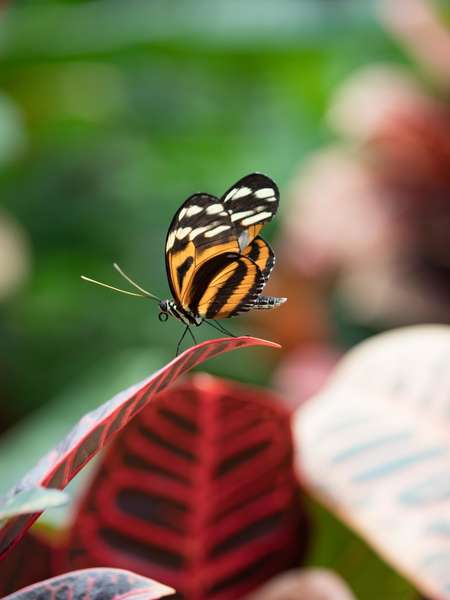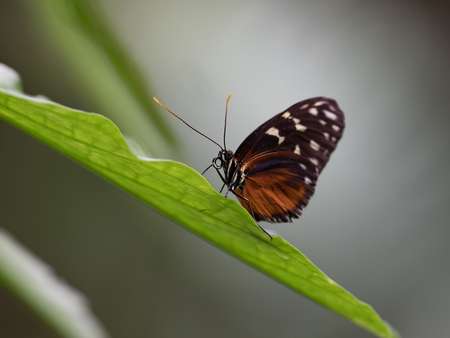One of my favorite insect subjects to photograph are the butteries. In my mind I see them as flying flowers thanks to their multitude of colors and shapes, and the almost comical whimsy they exhibit as they flutter around spring and summer landscapes.
Check out these quick and easy tips on using your Olympus camera to capture incredible photos of these fun and beautiful creatures.
EQUIPMENT
To photograph butterflies you can use everything from a camera in the OM-D and PEN line, to one of the Olympus point and shoot cameras such as the Tough or Stylus series.
Photographing butterflies is most easily done from a distance, so if you are shooting with one of the OM-D or PEN cameras you will want to use a lens that allows you to zoom in on the butterfly as they can often be easily scared off. I suggest a telephoto lens like the M.Zuiko 40-150mm f2.8 PRO, M.Zuiko 75-300mm, or the longest lens you have. I have even started shooting butterflies with the M.Zuiko 300mm f4.0 IS PRO! Overkill? No such thing! If you don’t have a telephoto lens try enabling the 2x teleconverter feature on your OM-D or PEN camera. This will turn any lens into a zoom lens!
TIMING
The ideal time to see and photograph butterflies is mid day to late afternoon, therefore we won’t need to use a flash or any other external light source other than the sun. I also suggest trying to keep the sun at your back. This will ensure that the butterflies are well lit and the iridescence of their wings shows.
SETTINGS
I like to set my camera to shutter priority (S on the mode dial) and adjust my shutter speed to the fastest I can get while still having a well exposed image. On a bright sunny day that can be 1/2000th of a second. This allows me to freeze any movement the butterfly may have while I am shooting. If you are not comfortable with manual controls, set your camera to the scene modes and choose the sports setting.
LOCATION
Chasing butterflies can be challenging when you aren’t sure where to find them.
If you don’t have a flower garden in your yard, I suggest paying a visit to a natural meadow or your Public Park that has flower gardens. Or, see if your local zoo has a butterfly exhibit and make a day trip to go shoot them. If you are very ambitious you could even plant a butterfly garden like I did!
One place that I am usually guaranteed a good photo or two is the local flower nursery. Try asking your local nursery owner for permission to photograph butterflies there and maybe in exchange give them a couple of prints to hang up. You can both benefit from that relationship. Give it a shot!
COMPOSITION
Now that you know what gear you need, what settings to use, and where to find the butterflies, you need to be able to compose a good shot! I suggest getting low, and level with the butterflies so that you aren’t shooting down on them. This can be done with the articulating or swivel screen on your camera, or even through using the O.I. Share app to control the camera. You can also find tall flowers, sit on a bench or stool at lower flowers, or if you really want to get into it just lie down in the grass. Since most people look at butterflies from above, shooting low allows you to capture a compelling photo by getting a perspective people usually don’t see.
Try to photograph them as they are feeding on flowers or as they drink water from the damp soil in a flower bed. When composing, be aware of distracting things in your background. I move around my subject to avoid having distractions behind the butterfly.
CAPTURING A BUTTERFLY IN FLIGHT
While a butterfly in flight is a sight to see, photographing one can be a trial in frustration due to their erratic flight. If you are shooting with the OM-D E-M1 Mark II, OM-D E-M1X, Tough TG-5, or Tough TG-6, use Pro Capture* to get great action shots of your butterfly taking flight from the flowers. If you don’t have Pro Capture, try shooting in burst mode to capture multiple images of the butterfly as it lands and feeds. Then select which image of that sequence you prefer.
* Editor’s note: The new Pro Capture feature allows you to buffer a running series of full resolution JPEG / RAW images when you press the shutter release button halfway. Then, fully press the shutter release to capture an image plus a set number of previous frames all at once.
MORE TIPS FOR CAPTURING BUTTERFLY PHOTOS LIKE A PRO
- Wear light colored clothing, white if possible. Dark clothes make you appear as a big scary silhouette and will make it harder to approach butterflies.
- Wear insect repellent if you are photographing butterflies in grassy fields. This will help keep ticks off!
- Watch which flowers the butterflies are frequenting and pre-focus on them.
- Don’t forget the sunscreen! You will be sitting in the sun while shooting.
- If hand holding your camera, make sure to use the image stabilizer to reduce camera shake.
- Experiment with the Art Filters! One that does great with shooting butterflies is the Pop Art er.
ABOUT JAMIE MACDONALD
Web: jmacdonaldphoto.com
Twitter: @MacDonald_Photo
Instagram: @MacDonald_Photo
Jamie MacDonald is a nature and stock photographer and social influencer living in Michigan’s Lower Peninsula. A husband and the father of two boys who are widely featured in his work, he describes his love of photography as one that is “rooted in the desire to move people to see the world around them in new ways.




